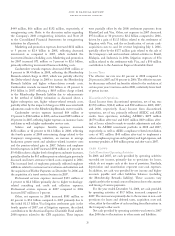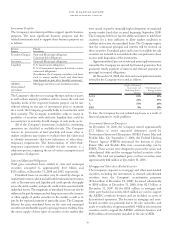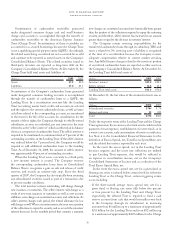American Express 2008 Annual Report Download - page 40
Download and view the complete annual report
Please find page 40 of the 2008 American Express annual report below. You can navigate through the pages in the report by either clicking on the pages listed below, or by using the keyword search tool below to find specific information within the annual report.
2008 financial review
american express company
Securitization of cardmember receivables generated
under designated consumer charge card and small business
charge card accounts is accomplished through the transfer of
cardmember receivables to the American Express Issuance
Trust (Charge Trust). Securitizations of these receivables are
accounted for as secured borrowings because the Charge Trust
is not a qualifying special purpose entity (QSPE). Accordingly,
the related assets being securitized are not accounted for as sold
and continue to be reported as owned assets on the Company’s
Consolidated Balance Sheets. The related securities issued to
third-party investors are reported as long-term debt on the
Company’s Consolidated Balance Sheets. At December 31, the
Charge Trust held total assets and liabilities of:
(Billions) 2008 2007
Assets $7.8 $9.0
Liabilities $5.0 $3.1
Securitization of the Company’s cardmember loans generated
under designated consumer lending accounts is accomplished
through the transfer of cardmember loans to a QSPE, the
Lending Trust. In a securitization structure like the Lending
Trust (a revolving master trust), credit card accounts are selected
and the rights to the current cardmember loans, as well as future
cash flows related to the corresponding accounts, are transferred
to the trust for the life of the accounts. In consideration for the
transfer of these rights, the Company, through its wholly-owned
subsidiaries, receives an undivided, pro rata interest in the trust
referred to as the “seller’s interest”, which is reflected on its balance
sheet as a component of cardmember loans. The seller’s interest is
required to be maintained at a minimum level of 7 percent of the
outstanding securities in the Lending Trust. If the seller’s interest
was reduced below the 7 percent level, the Company would be
required to add additional cardmember loans to the Lending
Trust. As of December 31, 2008, the amount of seller’s interest
was approximately 40 percent of outstanding securities.
When the Lending Trust issues a security to a third party,
a new investor interest is created. The Company removes
the corresponding cardmember loans from its Consolidated
Balance Sheets, recognizes a gain on sale and release of credit
reserves, and records an interest-only strip. Since the third
quarter of 2007, the Company has also typically been retaining
any subordinated securities issued as part of a transaction, due
to present market conditions.
The total investors’ interest outstanding will change through
new issuances or maturities. The seller’s interest will change as a
result of new trust issuances or maturities as well as new account
additions, new charges on securitized accounts, and collections. As
seller’s interest changes each period, the related allowance for loss
will change as well. When a security matures, the trust uses a portion
of the collections to repay the security, and as a result the investors’
interest decreases. In the monthly period that contains a maturity,
new charges on securitized accounts have historically been greater
than the portion of the collections required to repay the maturing
security, and therefore, seller’s interest has increased in an amount
greater than or equal to the decrease in investors’ interest.
The Company retains servicing responsibilities for the
transferred cardmember loans through its subsidiary, TRS, and
earns a related fee. No servicing asset or liability is recognized
at the time of a securitization because the Company receives
adequate compensation relative to current market servicing
fees. Any billed finance charges related to the investors’ portion
of securitized cardmember loans are reported as other assets on
the Company’s Consolidated Balance Sheets. At December 31,
the Lending Trust held total assets of:
(Billions) 2008 2007
Investors’ interest $29.0 $22.7
Seller’s interest 12.6 13.5
Lending Trust total assets $41.6 $36.2
At December 31, the fair value of the retained interests was as
follows:
(Millions) 2008 2007
Subordinated securities $744 $ 78
Interest-only strip 32 223
Total $776 $301
Under the respective terms of the Lending Trust and the Charge
Trust agreements, the occurrence of certain events could result in
payment of trust expenses, establishment of reserve funds, or in
a worst-case scenario, early amortization of investor certificates.
See Note 6 to the Consolidated Financial Statements for the
definition of Excess Spread, net, Total Excess Spread Rate, net,
and the related key metrics reported by each trust.
In the event the excess spread, net in the Lending Trust
becomes negative, and the issuer rate collections are utilized
to pay Lending Trust expenses, this would be reflected as
an expense in securitization income, net in the Company’s
Consolidated Statements of Income and as a reduction of the
Total Excess Spread Rate, net.
In the event the excess spread rate, net for a given fixed or
floating rate series is reduced below certain levels for either the
Lending Trust or the Charge Trust, certain triggering events
occur, including:
• If the three-month average excess spread rate, net for a
given fixed or floating rate series falls below five percent
or four percent for the Lending Trust and Charge Trust,
respectively, the affected Trust is required to fund a cash
reserve account (from cash that would normally revert back
to the Company through its subsidiaries) in increasing
amounts from $6 million up to a maximum of approximately
$2.0 billion for the Lending Trust and from $52 million up
to a maximum of approximately $207 million for the Charge
38
























